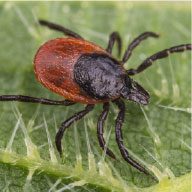Blacklegged Deer Ticks
Reddish-brown body with dark legs; females have a black shield on their back; broad, oval; around 1/8 of an inch in length

Diet: This species feeds on a variety of birds and mammals. Male ticks are not known to feed on blood, they just attach to the host.
Habitat: Blacklegged deer ticks need plenty of moisture and shade to survive. They are often found in areas with active deer and rodent populations as well as grassland with low-lying shrubbery and trees.
Threats: Blacklegged ticks, often referred to as deer ticks, are a vector of anaplasmosis, babesiosis, and Lyme disease. While a tick bite from this species is possible throughout the year, spring and summer are considered peak deer tick seasons. If humans are bitten, it is usually by nymphs and adults. In the adult life stage, only female ticks can transmit diseases.
Control: When in an area where ticks are common, wear long-sleeved shirts and pants that are light in color so ticks can be easier to detect. Similar to other tick species, keeping your lawn maintained with grass cut low, and removing debris can help reduce exposure to ticks.
